WordPress has a long, rich history. From releasing new technologies to expanding a tight-knit community, this platform has established itself as an industry giant. However, given its robust timeline, understanding every important development that’s happened over the past few decades can feel overwhelming.
Fortunately, it is possible to grasp the highlights of WordPress’ history. By dividing the platform’s past developments into relevant feature-based groups, you can obtain a big-picture view while still learning about critical details.
In this article, we’ll introduce you to WordPress and cover its developmental timeline. We’ll analyze the history of plugins, themes, community groups, and more before looking at the platform’s future. Let’s get started!
An Introduction to WordPress
Before we discuss its history, let’s spend some time considering WordPress in its current state. This free, open-source Content Management System (CMS) helps people create websites. You can hear a little bit more about it in this video:
There are other important features that define WordPress as well. Of course, since nearly half of all sites run on WordPress, you may already be familiar with the software.
The platform is undeniably an industry giant. As such, even people who have never heard of WordPress have likely visited a site supported by its infrastructure. Additionally, its growth shows no signs of slowing down any time soon.
You might be wondering how we got here, as growth like this doesn’t happen overnight. If you’re trying to predict where WordPress may be headed in the next few years, understanding its past is a solid starting point.
The Best Web Host for WordPress
Leave migrating your site, installing WordPress, managing security and updates, and optimizing server performance to us. Now you can focus on what matters most: growing your website.

The WordPress Timeline
Let’s kick things off by focusing on the software itself. We’ll take a look at how WordPress has developed since the early days of 2002, dividing the time until now into four distinct phases of development.
2002-2005: Getting Off the Ground
WordPress development began in 2002. It was initiated as an improvement on a competing CMS with waning popularity, b2/cafelog. Nevertheless, the new interface was distinct. Users who decided to give the new blogging platform a shot were greeted by this interface in 2003:
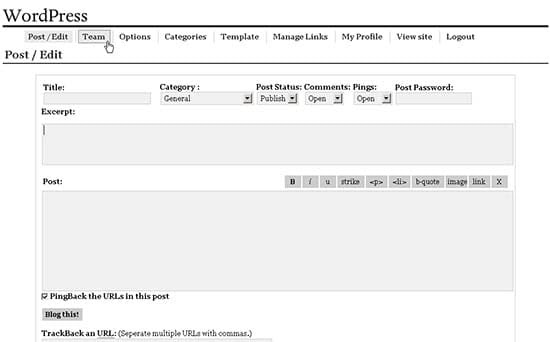
Its structure was based on the b2/cafelog model but with some upgrades. The interface was easier to interact with, and you could also choose from different templates to shape your content. Perhaps most important, however, was the reliance on the General Public License (GPL).
By licensing this CMS under the GPL, WordPress founders ensured that the software would remain free to use. Additionally, this license also enabled users to legally modify the code as much as they’d like. As such, the options for customization and evolution were nearly limitless.
Bloggers everywhere were immediately drawn to this flexible, easy-to-use haven. The number of users started to grow. In 2004, WordPress developers released version 1.2 of the software. This update provided more accessible features, which in turn attracted more users.
By 2005, it was becoming clear that WordPress was a platform with serious potential. Perhaps trying to capitalize on this, developers added the critical page creation function. This change provided users with more tools to create their own websites tailored to their exact needs. The same year also saw the founding of Automattic.
Other features present by this time included posting by email, common registration, and adding multiple authors. The simplicity of use without a price tag remained a priority. Usage continued to grow as more creators discovered this multi-tool for the web. Soon enough, WordPress had a loyal fanbase.
Related: How to Start a WordPress Blog: A Comprehensive Guide
2006-2010: Expanding the Community
The decisions over the next four years would reflect the value of the WordPress audience. Dedicated users were critical to the platform’s development, as they determined the direction of new features and often contributed time and resources to create them.
In 2006, Automattic was still relatively new. Nevertheless, the company moved forward to trademark WordPress and its logo. This branding remains today.

This legal action wasn’t the only development of the period. Developers continued to improve functionality in 2007. Some changes included refining the User Interface (UI), adding the ability to import features, and fixing various security issues.
Unfortunately, 2007 was also the year that WordPress experienced its first security breach. This shows that WordPress has been a target for malicious actors since the early days. It’s another reason to be vigilant about your site’s defense.
After the software was secured, more developments continued into 2008. One notable occurrence that year was the introduction of shortcodes. Shortcodes enable users to bracket text in posts and replace that text with dynamic features. This addition helped simplify the creation of complex posts.
Another essential feature added in 2008 was one-click updates. You might take it for granted now, but keeping your site current wasn’t always as easy as receiving an alert and clicking on a button. With this feature, more users were likely to complete updates with critical security patches.
Community-focused functionality continued to grow at the end of this period. 2009 saw improvements that included a built-in image editor, simplified video embedding, enhancements to elements that search engines ranked for, and post thumbnails.
Finally, with 2010 came the introduction of the custom post type. This boosted the flexible potential of WordPress even further and ushered in the age of meeting user needs.
Related: How to Write a Blog Post — A Step-By-Step Guide
2011-2015: Growing to Meet Users’ Needs
The addition of different post formats and an admin bar came in 2011. Both of these features made the WordPress User Experience (UX) easier to navigate. It also improved on the possibilities available to content creators.
The user-forward focus was paying off: In 2011, 50 million blogs ran on WordPress. Consumers seem to have appreciated their main role in the software’s development.
The progression didn’t stop there. In 2012, a new media manager was launched, making it even easier to add photos or videos to posts.

This made WordPress a more welcoming place for media-heavy blogs and text-based creators who enjoyed the simplicity of the interface.
Security and maintenance were evolving too. In 2013, automatic updates were released. This functionality only applied to small updates, but it still saved people time.
The same year, developers took note of the trend toward mobile devices. As such, a new, more responsive interface was added to increase accessibility across multiple devices.
In 2014, streamlined access was a priority for users. Several drag-and-drop improvements were made to the Classic editor, facilitating a more intuitive creative process. The developers also included a gallery preview option, taking significant guesswork out of the image posting equation.
Another media innovation of this year was the new playlist feature. This worked for both audio and visual components, making it simpler for users to post several related media files in a truncated way.
Then 2015 saw a big change: REST Application Programming Interfaces (API) infrastructure was added to the WordPress core. REST API enables other programs to access WordPress data from outside of the software itself.
This enabled users to integrate other tools with the platform easily. Therefore, the REST API was a significant contribution to the highly-tailored WordPress experience.
2016-2021: Refining the Modern Approach
You might consider 2016 the beginning of WordPress’ modern age. This is due to its relatively recent history, and also because it marked the start of several influential new features.
For instance, custom CSS was added to the Theme Customizer. This allowed users to make more stylistic changes through the Theme Editor. WordPress.org also announced that it would actively support Secure Hypertext Transfer Protocol (HTTPS), demonstrating the continued dedication to high-security standards.
2017 brought a modest yet impactful change: new default widgets. These widgets helped users add common content such as images and rich text in an intuitive way. If you’ve made frequent use of widgets on your WordPress dashboard, you might particularly appreciate the change.
After that, 2018 was a watershed year for WordPress history. Developers had been working on a project titled Gutenberg, available as a plugin during the creation stage. Gutenberg laid the foundations for the Block Editor, now the standard editor for WordPress, to thrive.
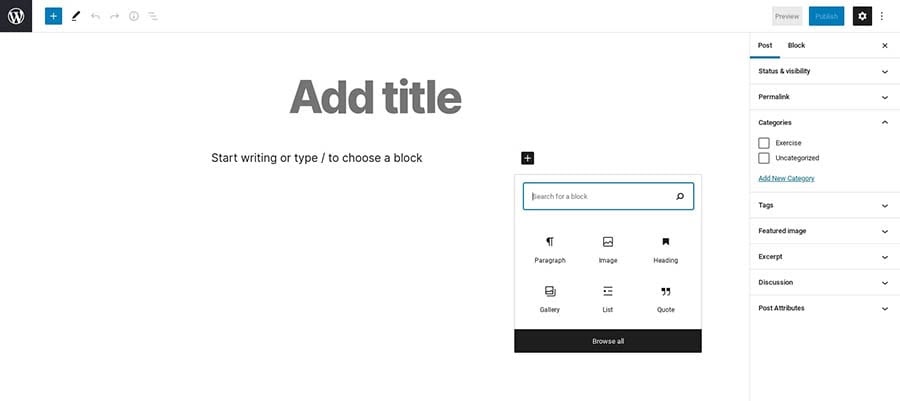
The Block Editor was revolutionary because it made post creation a more flexible experience. It did so by adding “blocks” or units of content that could freely move around. Each block was specialized for its content type. As such, the Block Editor marked a huge step forward for intuitive WordPress design.
With 2019 came adjustments to the Block Editor, security updates, and better debugging tools. 2020 was largely focused on the Block Editor as well, with new blocks, user improvements, and other changes taking place.
That brings us to today, in 2021. In the past couple of months, alterations have continued to roll out. Security has seen reinforcements, post-editing has been tweaked for ease of use, and behind-the-scenes technology has doubtless continued to develop.
The History of WordPress Plugins
WordPress plugins are third-party software that you can use to enhance your site. There are a huge number of these tools available today. You can search thousands of them with a visit to the WordPress Plugin Directory.
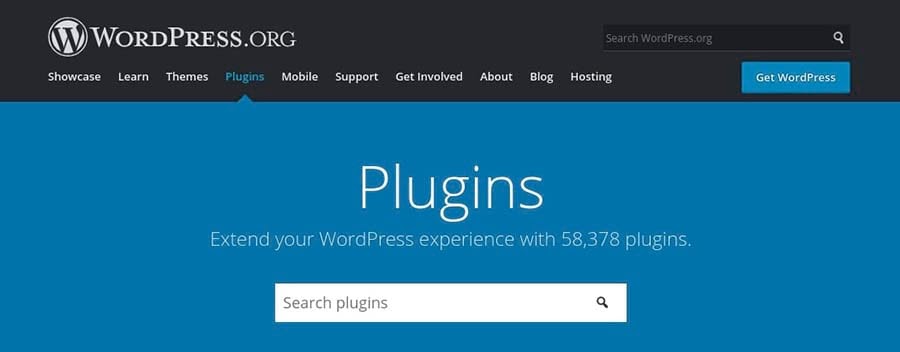
This repository has an inventory of over 58,000 plugins. Some are free, while others offer “freemium” plans (where users can download free versions with the option to upgrade to paid alternatives).
Plugins made their debut in 2004, with WordPress version 1.2. They were always meant to be crowd-sourced — that is, created and distributed by WordPress users themselves. These free-moving, effective extensions were instantly popular with fans.
In 2005, Akismet became the first plugin to be pre-installed with WordPress.

Akismet is an anti-spam tool that remains widely known and used to this day. With it, users could monitor their pages for harmful links or junk content. The release of the tool was an early and significant move towards a more secure platform for all.
The year 2010 saw the introduction of WordPress APIs. This technology made it easier to use third-party software to curate a WordPress website. As such, it’s become a huge asset to plugin creators.
In 2016, WordPress streamlined third-party software updates. Four years later, in 2020, updates were made automatic for plugins, helping to keep sites secure and plugins operational.
Today, the WordPress Plugin Directory remains a repository for third-party software. However, these tools continue to sell on private directories and developers’ personal sites. Therefore, users can rest assured that they have various ways to personalize their WordPress site.
The History of WordPress Themes
WordPress plugins weren’t the only third-party software to make a splash. WordPress themes have also played a critical role in the development of the platform. Themes control the look and feel of your site, giving you the freedom to brand your site however you see fit.
From the beginning, each version of WordPress included a default theme. The first of these was the Classic Theme, followed by Default (also known as Kubrick). To give users more options, the WordPress Theme Directory was launched in 2008, coming four years after its plugin counterpart.
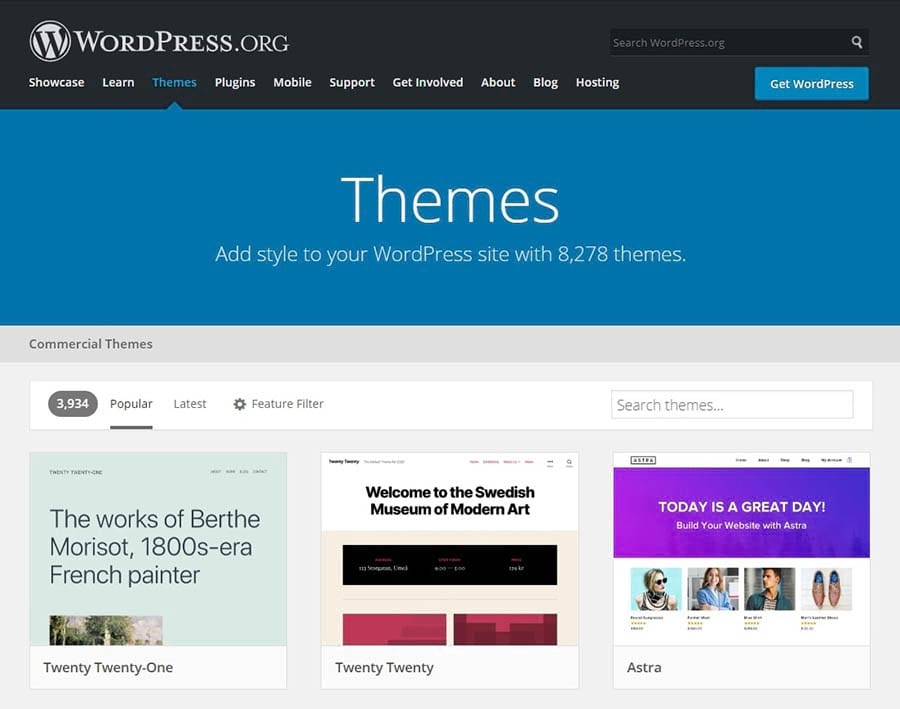
The introduction of this freely available marketplace helped expand the potential for individuality while also supporting community interactions. As such, it was a big moment in WordPress history.
The next important development for themes came in 2012. Users gained access to the Theme Customizer, opening up new possibilities for users willing to make adjustments. Themes became easier than ever to curate for individual sites. Theme previews also started this year, providing a critical front-end view.
The default WordPress themes continued to evolve as well. These themes are typically the first that many users create with and are often designed to make the best use of cutting-edge WordPress technology.
In 2019, the Twenty Twenty theme was released and included a unique feature: It was designed for compatibility with the Block Editor. This decision signaled that the Block Editor was here to stay and encouraged users to optimize their sites for its use.
These days, the Theme Directory remains a robust resource for top-notch themes. However, you can also find plenty of legitimate premium and developer-run sites if you’re on the lookout for even more variety.
The History of the WordPress Community
The history of WordPress is largely defined by its dedication to those who use it most. Here are some critical areas where the WordPress community has grown over the years.
Core Contributors
Let’s begin with the WordPress founders. In 2002, Matt Mullenweg was an active blogger. His platform of choice was the popular b2/cafelog CMS. Mullenweg, along with his fellow users, used this technology heavily.
Unfortunately, the developers stopped updating the project that same year. Without updates or support, Mullenweg and his colleagues were left without a platform. Perhaps feeling that it didn’t make sense for a CMS’s success to hinge on one team of developers, he set out to create his own.
Mullenweg partnered with developer Mike Little to get the project off the ground. Together, the duo released the first version of WordPress in 2003. Later on, the founding of Automattic became critical for the business-side of WordPress.

Automattic proved to be invaluable for the raising of necessary capital. The company received an influx of funding for WordPress, setting the stage for important developments and new features.
By 2010, Automattic had decided to place a heavier emphasis on keeping WordPress open source. The company launched the WordPress Foundation, an organization dedicated to the accessible, community-oriented values of WordPress software.
This decision made WordPress’ reliance on the free exchange of information between users official. This trend continues with the presence of so-called “core contributors.”
Core contributors are individuals who develop WordPress on a consistent basis. WordPress does not employ them, nor are they compensated for their time. Rather, they volunteer their skills to help make WordPress a better platform for everyone.
Considering their significant work, core contributors remain critical to the software’s success. Furthermore, their role as loyal fans collaborating for a better future is largely reflective of the WordPress identity as a whole. If you’re interested in being a part of WordPress history, consider getting involved as a core contributor.
WordCamps
The open-source nature of WordPress earned it plenty of fans in the early days. However, as the WordPress platform grew, users started looking for a more official way to share their passion. In 2006, they found their answer: WordCamps.
WordCamps began as simple ways for WordPress enthusiasts to meet up and discuss the growing project. The idea was a hit, and today there are large annual events for users all around the world.

The scope of WordCamps is fairly broad. However, discussions tend to focus on WordPress’ technological advancements. In this sense, WordCamps center on the development of the user community as a whole. If you’re interested in getting involved with WordCamp, you have a few options.
If you have a knack for administration, for example, you might want to apply to act as an organizer. You might also choose to be a speaker and participate in WordCamp events. Alternatively, you could always apply as a volunteer, and pitch in wherever you’re needed.
WordPress Meetups
WordCamps are relatively structured, global events. However, there’s another option if you’re looking for a community a little closer to home: WordPress Meetups. Organized on the Meetup website, these events boast 822,736 members in over 1,551 groups.
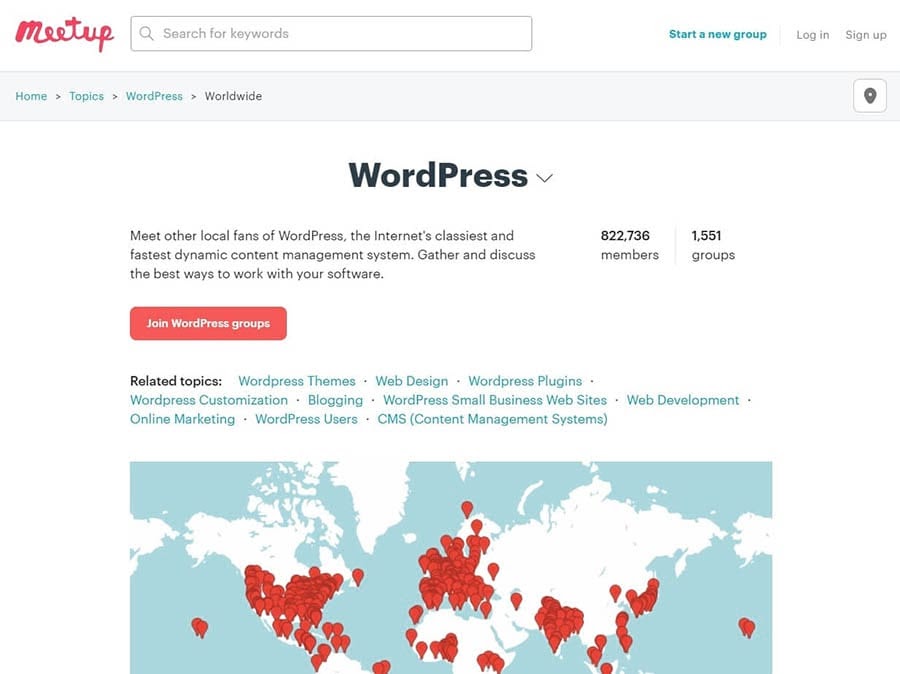
These are localized events, as you can see from the map above. People from across the world can get together with other enthusiasts in their communities and discuss the platform. These gatherings tend to be more informal than the WordCamps.
They also happen more frequently since they require fewer resources to organize. A handful of interested users can simply agree on a meeting place ahead of time or even conduct their meetings over video calls.
Despite the smaller scale of Meetups, they remain vital to the WordPress community. They facilitate the sharing of ideas and provide a sense of community. Moreover, the consistent nature of Meetups can help to develop ideas over time.
There are several WordPress Meetups around the world. However, you may not have any Meetups in your area. It’s also possible that there are dormant groups in your community. This occurs when a Meetup has not been disbanded but has also not been recently active.
Fortunately, anyone can host. Consider visiting the Meetup page and starting your own group! If your local group is inactive, you might try reaching out to current members to re-establish the meetings.
The History of Managed WordPress Hosting
In the early days of WordPress, membership grew quickly. By 2006, there was significant demand for web hosting that could meet the platform’s needs. WordPress had become. Over time, hosting companies learned the best way to tailor their services to WordPress users.
Managed hosting takes many technical tasks off your plate. Site maintenance, security, migration, and upgrades are handled by professionals instead. You can use the extra time to keep your site running exactly the way you want it.
If you want to learn more, you can check out our own managed hosting service: DreamPress. With the addition of high-speed Solid State Drives in 2015, we set ourselves apart from the crowd. We also offer a variety of pricing plans to fit your budget and technical skills.
Take Your WordPress Website to the Next Level
Whether you need help navigating the WordPress Admin Dashboard, fixing a WordPress database error, or adding a widget, we can help! Subscribe to our monthly digest so you never miss an article.

The History of WooCommerce
WooCommerce is one of the most widely-used plugins available for WordPress today with over five million active installations. However, WooCommerce wasn’t always specifically focused on e-commerce.
In 2008, a few developers founded WooThemes. As you might expect, they largely focused on providing new themes for WordPress users. However, this was soon to change.
2011 saw the use of ecommerce plugins increase. This functionality started to become more popular among WordPress users. As such, the idea of using the platform to support online stores began to spread. WooThemes released WooCommerce to join in on the trend.

WooCommerce became a preferred choice for WordPress users. By 2015, its frequent use caught Automattic’s attention, and the company acquired this popular plugin. By 2017 WooCommerce hit $10 billion in sales — a watershed moment in WordPress history.
Today, the plugin continues to be updated, developed, and improved. However, it’s not without its competitors. Options such as Shopify have sprouted up as formidable alternatives, encouraging more frequent innovations.
Related: Looking for a Brilliant Blogging Tool? These Solutions Will Help You Write Better, Publish More, and Increase Traffic
The Future of WordPress
Predicting the future is no small task. Nevertheless, we can take a few clues from the history of WordPress up until now to make some educated projections.
For one thing, development continues on the Block Editor. As it improves and becomes a more integrated part of WordPress, we’ll doubtless see new features.
You might also expect this technology to become more intuitive and widely used. If you’re curious about keeping up with these developments, consider installing the Gutenberg plugin to stay informed.

As for WordPress’ popularity, its web share has grown over the past few years. There’s little reason to think that this pattern will change. This seems especially true with the WordPress community actively working to enhance its features.
If you’d like to be a member of the group steering WordPress towards tomorrow, consider getting involved as a core contributor, developer, or even just starting your own site. You could also keep up with broader internet trends, such as Search Engine Optimization (SEO) developments.
However you choose to use WordPress, one thing seems sure for the platform — its future looks bright.
Related: 13 Simple Ways to Boost WordPress SEO
The Evolution of WordPress
As odd as it might seem, the internet is still relatively new. Therefore, taking a historical view of it can be difficult. This task only complicates further when you try to focus on something as widespread as WordPress. Fortunately, you can see important trends by looking at key moments of its development.
In this article, we covered the evolution of WordPress features from 2002 onward. Additionally, we looked at specific areas of growth, such as the strength of the WordPress community and the use of third-party software.
We also discussed the history of managed hosting. We’ve been providing WordPress-optimized managed hosting for many years. If you’re interested in taking your site to the next level with ease, consider contacting our team and asking about DreamPress!
The post The History of WordPress: An In-Depth Look at the Most Popular CMS appeared first on Website Guides, Tips & Knowledge.
source https://www.dreamhost.com/blog/history-of-wordpress/

No comments:
Post a Comment